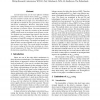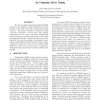43 search results - page 1 / 9 » Comparison of Effectiveness of Current Ratio and Delta-IDDQ ... |
VLSID
2004
IEEE
14 years 5 months ago
2004
IEEE
IDDQ test is a valuable test method for semiconductor manufacturers. However, its effectiveness is reduced for deep sub-micron technology chips due to rising background leakage. C...
ITC
2003
IEEE
13 years 10 months ago
2003
IEEE
Current-based tests are the most effective methods available to detect resistive shorts. Delta IDDQ testing is the most sensitive variant and can handle off-state currents of 10-1...
ITC
2000
IEEE
13 years 9 months ago
2000
IEEE
The use of a single pass/fail threshold for IDDQ testing is unworkable as chip background currents increase to the point where they exceed many defect currents. This paper describ...
DFT
2003
IEEE
13 years 10 months ago
2003
IEEE
Increased leakage and process variations make distinction between fault-free and faulty chips by IDDQ test difficult. Earlier the concept of Current Ratios (CR) was proposed to sc...
DFT
2002
IEEE
13 years 9 months ago
2002
IEEE
IDDQ test loses its effectiveness for deep sub-micron chips since it cannot distinguish between faulty and fault-free currents. The concept of current ratios, in which the ratio o...


